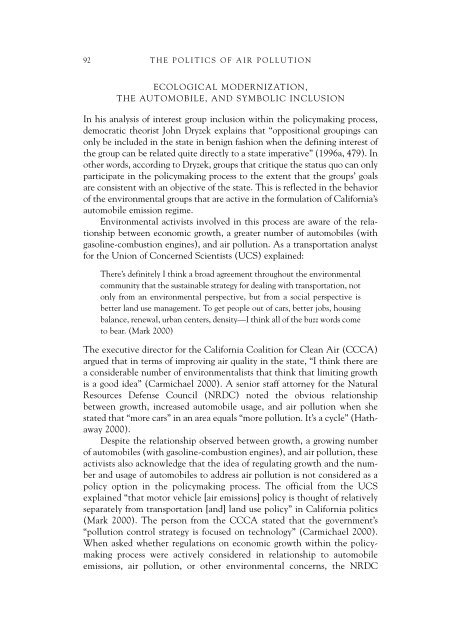GEORGE A. GONZALEZ - fieldi
GEORGE A. GONZALEZ - fieldi
GEORGE A. GONZALEZ - fieldi
Create successful ePaper yourself
Turn your PDF publications into a flip-book with our unique Google optimized e-Paper software.
92THE POLITICS OF AIR POLLUTIONECOLOGICAL MODERNIZATION,THE AUTOMOBILE, AND SYMBOLIC INCLUSIONIn his analysis of interest group inclusion within the policymaking process,democratic theorist John Dryzek explains that “oppositional groupings canonly be included in the state in benign fashion when the defining interest ofthe group can be related quite directly to a state imperative” (1996a, 479). Inother words, according to Dryzek, groups that critique the status quo can onlyparticipate in the policymaking process to the extent that the groups’ goalsare consistent with an objective of the state. This is reflected in the behaviorof the environmental groups that are active in the formulation of California’sautomobile emission regime.Environmental activists involved in this process are aware of the relationshipbetween economic growth, a greater number of automobiles (withgasoline-combustion engines), and air pollution. As a transportation analystfor the Union of Concerned Scientists (UCS) explained:There’s definitely I think a broad agreement throughout the environmentalcommunity that the sustainable strategy for dealing with transportation, notonly from an environmental perspective, but from a social perspective isbetter land use management. To get people out of cars, better jobs, housingbalance, renewal, urban centers, density—I think all of the buzz words cometo bear. (Mark 2000)The executive director for the California Coalition for Clean Air (CCCA)argued that in terms of improving air quality in the state, “I think there area considerable number of environmentalists that think that limiting growthis a good idea” (Carmichael 2000). A senior staff attorney for the NaturalResources Defense Council (NRDC) noted the obvious relationshipbetween growth, increased automobile usage, and air pollution when shestated that “more cars” in an area equals “more pollution. It’s a cycle” (Hathaway2000).Despite the relationship observed between growth, a growing numberof automobiles (with gasoline-combustion engines), and air pollution, theseactivists also acknowledge that the idea of regulating growth and the numberand usage of automobiles to address air pollution is not considered as apolicy option in the policymaking process. The official from the UCSexplained “that motor vehicle [air emissions] policy is thought of relativelyseparately from transportation [and] land use policy” in California politics(Mark 2000). The person from the CCCA stated that the government’s“pollution control strategy is focused on technology” (Carmichael 2000).When asked whether regulations on economic growth within the policymakingprocess were actively considered in relationship to automobileemissions, air pollution, or other environmental concerns, the NRDC









